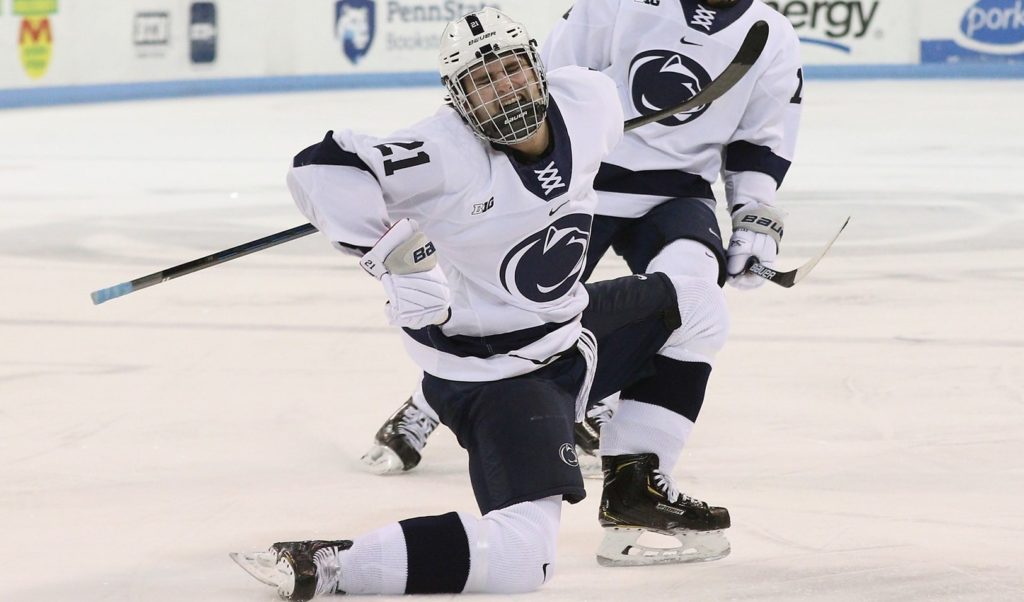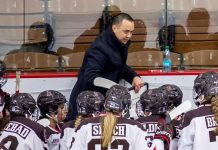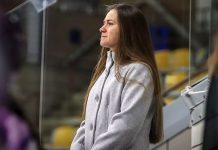
When Penn State hosts Michigan this week, the Nittany Lions will be looking for their first win of the season.
With sweeps at the hands of Minnesota and Wisconsin to start this current campaign, Penn State appears to be very different from the team it was last March, when the Nittany Lions ended 2019-20 as regular-season Big Ten champions.
Of course, everything is very different now.
There are challenges that teams never had to think about before, said Penn State coach Guy Gadowsky.
“How you dress, how you meet as a team, how you talk to the team, how long you can meet for – all of those things are very different,” Gadowsky said.
Like everyone else, the Nittany Lions are adjusting to life during the COVID-19 pandemic. Unlike most of the other teams in the Big Ten, though, Penn State is adjusting to life after turnover in nearly every key. Gone are five of last year’s top scorers who accounted for 52 of the Nittany Lions’ 121 goals, 42 percent of last year’s scoring.
Among those players was Cole Hults, a two-way defenseman who departed for the professional ranks at the end of his junior season. His absence is felt keenly on the blue line.
Gone, too, is goaltender Peyton Jones, the four-year starter whose steady play fueled confidence in the Nittany Lions’ aggressive, rushing and often risky offense.
With six rookies on the roster and two veteran transfers – and COVID-19 safety protocols that don’t lend themselves well to early team-building – it would be easy to admit that the Nittany Lions need to make some player adjustments and learn to function as a cohesive unit. That may also be the fair thing to say.
That is not, however, the way Gadowsky sees Penn State’s 0-4 start, with its lagging offense and nationally last-place defense.
“We have to coach better,” said Gadowsky. “We have to do a better job. That’s not just goaltending or ‘D.’ That’s as a team, certainly to give them the structure and reps and understanding to know what’s going on, and I haven’t done a very good job of that.”
Gadowsky said that the kinds of things that coaches need to do now because of the pandemic – meet with players virtually, address small groups more frequently – are things to which he is still adjusting.
“There are other coaches who are dealing with the same thing and have figured out how to be more effective on Zoom or however they’re doing things,” said Gadowsky. “I have done a very poor job of coaching the way I coach with the limitations that we have. That’s what I’ve got to figure out.
“We have to be more innovative. We have to figure out a way to adapt so that we can coach effectively. Up to this point, I certainly haven’t coached effectively.”
While it is impossible to separate the game from the pandemic, Gadowsky said that COVID-19 is “all very much in the forefront, until you play. And then it matters if you win or lose. It’s really interesting.
“The health and safety of our student-athletes is always our No. 1 priority – always – and that doesn’t change, but it’s interesting that it starts as all you talk about until you lose a game. And then, all of a sudden, you talk about a lot of other things.”
While the coaches are dealing with those other things – whether Oskar Autio or Liam Souliere will start in net and how to improve Penn State’s last-place combined special teams, for example – Gadowsky said that the Nittany Lions are fortunate to have the vigilance of athletic trainer Justin Rogers, who is tasked with making sure that the players remain safe during the pandemic.
“He has been a rock star through all of this,” said Gadowsky. “Really, it’s him who is responsible for instituting and keeping accountable all the protocols, additional protocols, that are coming at us. The challenges you don’t normally think of – even eating as a team, it looks very different now than it did in the past. He’s prepared us for what we have to do to try to be as efficient and effective as possible. We as a coaching staff, we don’t have to deal with that because he’s so good.”
This week, the Nittany Lions host Michigan, and Gadowsky said that he and his staff can only focus on what Penn State can do, not what a young and talented Wolverine team may potentially do in Pegula Arena. With some rebuilding to do and an 0-4 start, though, Gadowsky said that the goals of the team haven’t changed.
“Whether you’re the No. 1-ranked team going into the season or the 60th-ranked team, the value of development is what’s really going to allow you to be successful in the end, no matter where you start,” said Gadowsky. “If you win the Big Ten regular season, there’s no luck involved in that. To do it over the course of a season, I don’t think that’s a coincidence.
“Every year, the goal to get better every week is extremely important wherever you start. Right now, look, it’s been two weekends. Starting on the road … was the first time I’d ever talked to the whole team together in one room. There’s a lot of growth that’s going to happen.
“Four games. We have the same purpose in mind to get better every week, regardless of whether we were 4-0 or 0-4.”
Speaking of COVID-19 protocols
Last week, four Wisconsin forwards were scratched from the lineup in the Badgers’ series against Arizona State, reportedly due to COVID-19 exposure.
According to Todd Milewski’s reporting for the Wisconsin State-Journal, one of the four players – Tarek Baker, Ty Pelton-Byce, Roman Ahcan and Dominick Mersch – has tested positive for COVID-19, but since all four live together, as close contacts they must all quarantine.
Big Ten protocol dictates that players participating in any sport who test positive for COVID-19 must quarantine for 21 days. The Big Ten also directs close contacts of infected players to self-quarantine for 14 days following their interaction with COVID-positive player. The 14-day rule comes directly from the CDC.
According the league, specific names are not released so as to avoid violating the Health Insurance Portability and Accountability Act of 1996, commonly known as HIPAA. Also, schools are wary of creating conditions of potential future bias that may harm a player’s professional chances, so most schools opt to release the number of players affected and not specific names.
The four Wisconsin players currently quarantined will miss the rest of Wisconsin’s games through December. That puts the Badgers in a bind, as two other forwards – Dylan Holloway and Cole Caufield – will miss the rest of this condensed first half of the season because they’ll be playing in the World Junior championship. Holloway’s already gone, having left Nov. 15 for Team Canada, and Caufield leaves for the Team USA camp, which begins Dec. 6.
Schedule not all that’s condensed
If the pace of the Big Ten first-half schedule seems a little dizzying, consider the impact on the players who are accustomed to more time between the series they usually play.
The league itself thought of that and made some changes to help speed up the games themselves, including shortening intermissions between periods to 12 minutes and eliminating two of the three television timeouts per period in games that are not televised.
Gadowsky is a big fan of what the league is doing.
“I think it’s great hockey to watch,” said Gawdowsky. “What I mean by that is I love the initiatives that the Big Ten put in place regarding speeding up the games. Intermissions are a little quicker, the faceoffs are faster, there’s less stoppages, there’s less timeouts.”
Gadowsky, who came to Penn State from Princeton, said that the changes remind him of how the ECAC was focused on finishing games in under two hours whenever possible.
“That was our goal and we had several that did that,” he said. “I think that it improves the quality of the entertainment value.”


